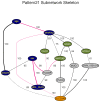Graphical modeling of gene expression in monocytes suggests molecular mechanisms explaining increased atherosclerosis in smokers
- PMID: 23372645
- PMCID: PMC3553098
- DOI: 10.1371/journal.pone.0050888
Graphical modeling of gene expression in monocytes suggests molecular mechanisms explaining increased atherosclerosis in smokers
Abstract
Smoking is a risk factor for atherosclerosis with reported widespread effects on gene expression in circulating blood cells. We hypothesized that a molecular signature mediating the relation between smoking and atherosclerosis may be found in the transcriptome of circulating monocytes. Genome-wide expression profiles and counts of atherosclerotic plaques in carotid arteries were collected in 248 smokers and 688 non-smokers from the general population. Patterns of co-expressed genes were identified by Independent Component Analysis (ICA) and network structure of the pattern-specific gene modules was inferred by the PC-algorithm. A likelihood-based causality test was implemented to select patterns that fit models containing a path "smoking→gene expression→plaques". Robustness of the causal inference was assessed by bootstrapping. At a FDR ≤0.10, 3,368 genes were associated to smoking or plaques, of which 93% were associated to smoking only. SASH1 showed the strongest association to smoking and PPARG the strongest association to plaques. Twenty-nine gene patterns were identified by ICA. Modules containing SASH1 and PPARG did not show evidence for the "smoking→gene expression→plaques" causality model. Conversely, three modules had good support for causal effects and exhibited a network topology consistent with gene expression mediating the relation between smoking and plaques. The network with the strongest support for causal effects was connected to plaques through SLC39A8, a gene with known association to HDL-cholesterol and cellular uptake of cadmium from tobacco, while smoking was directly connected to GAS6, a gene reported to have anti-inflammatory effects in atherosclerosis and to be up-regulated in the placenta of women smoking during pregnancy. Our analysis of the transcriptome of monocytes recovered genes relevant for association to smoking and atherosclerosis, and connected genes that before, were only studied in separate contexts. Inspection of correlation structure revealed candidates that would be missed by expression-phenotype association analysis alone.
Conflict of interest statement
Figures




Similar articles
-
SASH1, a new potential link between smoking and atherosclerosis.Atherosclerosis. 2015 Oct;242(2):571-9. doi: 10.1016/j.atherosclerosis.2015.08.013. Epub 2015 Aug 14. Atherosclerosis. 2015. PMID: 26318107
-
Identification of potential therapeutic targets for atherosclerosis by analysing the gene signature related to different immune cells and immune regulators in atheromatous plaques.BMC Med Genomics. 2021 Jun 3;14(1):145. doi: 10.1186/s12920-021-00991-2. BMC Med Genomics. 2021. PMID: 34082770 Free PMC article.
-
Isolation, culturing and gene expression profiling of inner mass cells from stable and vulnerable carotid atherosclerotic plaques.PLoS One. 2019 Jun 26;14(6):e0218892. doi: 10.1371/journal.pone.0218892. eCollection 2019. PLoS One. 2019. PMID: 31242269 Free PMC article.
-
How Monocytes Contribute to Increased Risk of Atherosclerosis in Virologically-Suppressed HIV-Positive Individuals Receiving Combination Antiretroviral Therapy.Front Immunol. 2019 Jun 19;10:1378. doi: 10.3389/fimmu.2019.01378. eCollection 2019. Front Immunol. 2019. PMID: 31275317 Free PMC article. Review.
-
Changes in transcriptome of macrophages in atherosclerosis.J Cell Mol Med. 2015 Jun;19(6):1163-73. doi: 10.1111/jcmm.12591. Epub 2015 May 13. J Cell Mol Med. 2015. PMID: 25973901 Free PMC article. Review.
Cited by
-
Influence of Smoking Status and Intensity on Discovery of Blood Pressure Loci Through Gene-Smoking Interactions.Genet Epidemiol. 2015 Sep;39(6):480-488. doi: 10.1002/gepi.21904. Epub 2015 May 3. Genet Epidemiol. 2015. PMID: 25940791 Free PMC article.
-
Immune cell-specific smoking-related expression characteristics are revealed by re-analysis of transcriptomes from the CEDAR cohort.Cent Eur J Immunol. 2022;47(3):246-259. doi: 10.5114/ceji.2022.120618. Epub 2022 Nov 16. Cent Eur J Immunol. 2022. PMID: 36817262 Free PMC article.
-
A Transcriptomic Analysis of Smoking-Induced Gene Expression Alterations in Coronary Artery Disease Patients.Int J Mol Sci. 2023 Sep 10;24(18):13920. doi: 10.3390/ijms241813920. Int J Mol Sci. 2023. PMID: 37762221 Free PMC article.
-
Association of smoking with neurocognition, inflammatory and myeloid cell activation profiles in people with HIV on antiretroviral therapy.AIDS. 2024 Dec 1;38(15):2010-2020. doi: 10.1097/QAD.0000000000004015. Epub 2024 Sep 13. AIDS. 2024. PMID: 39283742
-
In utero gene expression in the Slc39a8(neo/neo) knockdown mouse.Sci Rep. 2018 Jul 16;8(1):10703. doi: 10.1038/s41598-018-29109-y. Sci Rep. 2018. PMID: 30013175 Free PMC article.
References
-
- McGill HC Jr (1990) Smoking and the pathogenesis of atherosclerosis. Adv Exp Med Biol 273: 9–16. - PubMed
-
- Teo KK, Ounpuu S, Hawken S, Pandey MR, Valentin V, et al. (2006) Tobacco use and risk of myocardial infarction in 52 countries in the INTERHEART study: a case-control study. Lancet 368: 647–658 doi:10.1016/S0140-6736(06)69249-0. - DOI - PubMed
-
- Yusuf S, Hawken S, Ounpuu S, Dans T, Avezum A, et al. (2004) Effect of potentially modifiable risk factors associated with myocardial infarction in 52 countries (the INTERHEART study): case-control study. Lancet 364: 937–952 doi:10.1016/S0140-6736(04)17018-9. - DOI - PubMed
-
- Campbell SC, Moffatt RJ, Stamford BA (2008) Smoking and smoking cessation—The relationship between cardiovascular disease and lipoprotein metabolism: A review. Atherosclerosis 201: 225–235 doi:10.1016/j.atherosclerosis.2008.04.046. - DOI - PubMed
-
- Gastaldelli A, Folli F, Maffei S (2010) Impact of tobacco smoking on lipid metabolism, body weight and cardiometabolic risk. Curr Pharm Des 16: 2526–2530. - PubMed
Publication types
MeSH terms
Substances
LinkOut - more resources
Full Text Sources
Other Literature Sources
Medical
Miscellaneous

